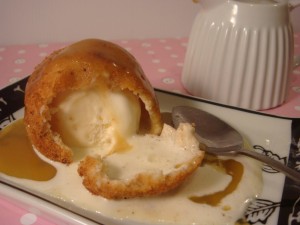I’ve never had fried ice-cream; maybe it’s an Australian thing. But Australia does have an egg problem. And in mid-August 2010, the New South Wales Food Authority received a complaint from a member of the public alleging foodborne illness from a restaurant in the eastern suburbs of Sydney. The complaint information was that a family group had been to the restaurant for  dinner about two weeks before and 7 individuals had become ill with gastroenteritis. Several people were hospitalized because of the gastroenteritis and stool samples had revealed the presence of Salmonella bacteria.
dinner about two weeks before and 7 individuals had become ill with gastroenteritis. Several people were hospitalized because of the gastroenteritis and stool samples had revealed the presence of Salmonella bacteria.
The food history supplied to the Authority by the complainant indicated that the only person not ill in the party was the one who did not consume fried ice-cream. Officers from the Authority went to the restaurant that evening to interview the management and staff, inspect the kitchen, and take environmental and food samples for microbiological analysis.
The Authority received a second complaint two weeks later regarding another family group that had 4 members ill with gastroenteritis. This family group had attended the restaurant and had also consumed fried ice-cream 5 days prior to the Authority’s inspection for the first complaint. One of these cases had tested positive for Salmonella after seeing a doctor.
The kitchen at the time of inspection had some minor construction and hygiene issues which were the subject of a subsequent Improvement Notice. The restaurant was advised to remove fried ice-cream from the menu until further notice.
Authority officers interviewed the restaurant manager and head chef regarding the processing of fried ice-cream from preparation to serving to customers. The uncooked fried ice-cream coating was found to be made with raw eggs which is a potential source of Salmonella. The cooking of the frozen coated ice-cream ball involved putting the food into hot oil in a wok and turning the ice-cream ball to ensure the egg coating is set before serving.
Authority officers took environmental swabs of selected areas of the kitchen and equipment. Food samples were also taken of the frozen uncooked ice-cream balls, uncooked coating fragments, a ‘test’ cooked fried ice-cream ball from the same uncooked batch and raw eggs present at the premises.
The sample of uncooked fried ice-cream balls stored for sale found in the freezer on the Friday night were most probably from the same batch as the ones that were consumed by the second group 5 days prior to the inspection. They were possibly from the same batch as those consumed by the group which first complained.
The samples of coating fragments, uncooked coated ice-cream balls and ‘test’ cooked ice-cream ball were all positive for the same strain of Salmonella. indicating that the wok frying to set the coating was inadequate to kill the bacteria. Further, DNA fingerprinting (MLVA) of the salmonella strain by the laboratory showed a match between the clinical samples taken from the Salmonella cases for both groups and the strain of Salmonella isolated from the food samples taken from the restaurant, strongly supporting the ice-cream balls with the egg coating being the culprit food.
The brief cooking in the wok of egg coated fried ice cream is insufficient to destroy Salmonella and is designed only to set the outer layer of the coating as any longer will melt the ice cream. Further cooking also darkens the coating making the food unappetizing and undesirable.
The Authority findings, including Salmonella-positive food sample results, support previous investigations both locally and overseas regarding the food safety risks of fried ice-cream prepared using raw eggs. If the Salmonella bacteria is present either on the outside of the shell or inside the egg, then pooling eggs for a coating will spread the bacterial contamination throughout the batch.
What should the business have done?
As well as other food safety practices: use pasteurised egg product or an alternative binding agent for the coating mixture instead of raw whole eggs.
